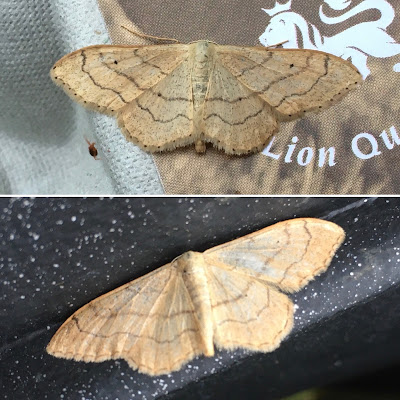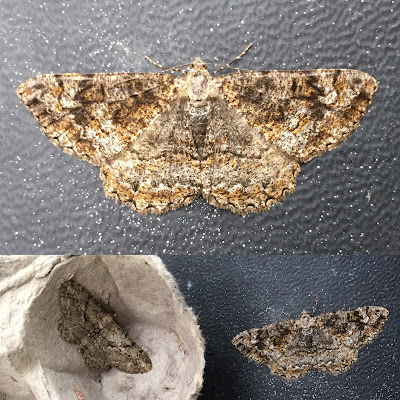I hid the light under the proverbial bush last night, or rather between two bushes: our burgeoning potato crop and a mini-forest of Jerusalem Artichokes. The latter are interesting as a plant which is neither an artichoke nor has any connection with Jerusalem. Sorry to divert from moths, but its knobbly roots happen to taste identical to a Globe Artichoke's yummy flowerhead and its very tall yellow blooms resemble sunflowers - in Italian girasole ('turns to the sun' like the French equivalent tournesol) which our ancestors Anglicised into 'Jerusalem'. I hope that helps in pub quizzes.
 Anyway, sitting delightfully on a girasole leaf was the year's first Procul Harum moth - remember Nights in White Satin? This is a White Satin, a very pure-looking creature although, like all moths, its main interest during its short life will be reproduction. Below is a second newcomer for the year, a Light Arches, tucking itself comfortably into an eggbox cone. It has a rakish look, accentuated by the slanting eyes which we saw the other day in the slightly similar Clay.
Anyway, sitting delightfully on a girasole leaf was the year's first Procul Harum moth - remember Nights in White Satin? This is a White Satin, a very pure-looking creature although, like all moths, its main interest during its short life will be reproduction. Below is a second newcomer for the year, a Light Arches, tucking itself comfortably into an eggbox cone. It has a rakish look, accentuated by the slanting eyes which we saw the other day in the slightly similar Clay.Next, boldly obscuring the British egg lion, is a Riband Wave with a second perched on the edge of the trap bowl. The Waves are a small but - to me - often confusing family with quite small differences between the various species. But all are the epitome of grace.
You need no introduction to the Elephant Hawks but their almost everyday arrival in June never dulls the beauty of their colours for me. Here are an Elephant and a Small Elephant meeting on an eggbox. The latter's almost-glowing pink and orange wins the award by a narrow margin so far as I am concerned.
Here are three Mottled Beauties, a well-named moth whose complicated colours and patterning repays a long, close look. And below that, the simpler loveliness of a Brimstone, another regular whose vivid colours always brighten up the gloomy recesses of the trap bowl.
Finally, yet another newcomer for the year: a Common Emerald. common but glorious although that lovely green fades very quickly during the moth's brief adult life.







No comments:
Post a Comment